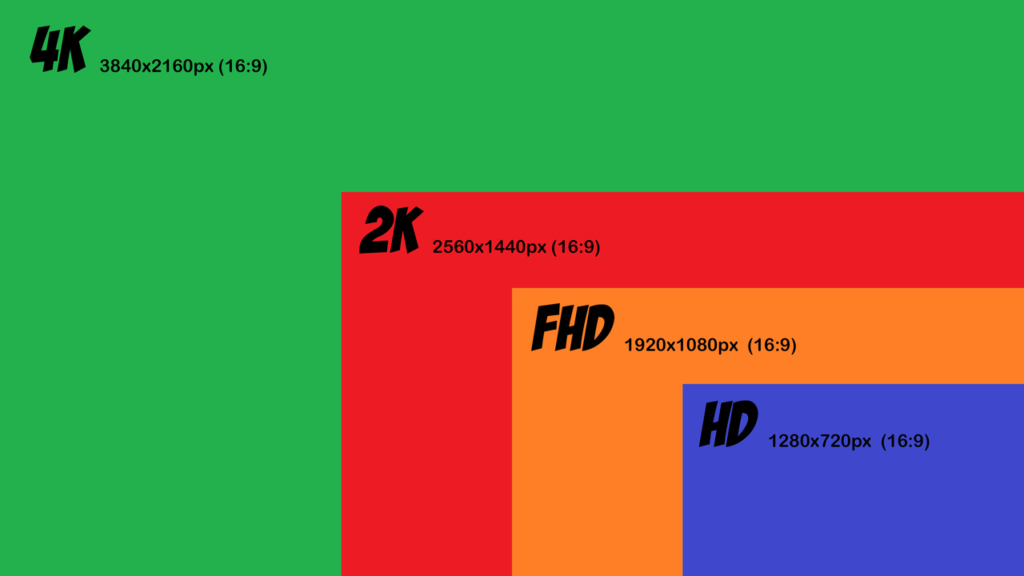Is HD ready, Full HD, Ultra HD. which definition to choose?
Projector resolutions are important to a clear and crisp image. The higher the resolution, the better the display will be, and it will be sharper on the screen.
There is a minimum standard for displays of 1080p for HD TVs, but some new models can go as high as 4K!
HD and 4K
The resolution of a projector is the number of pixels that it can show. It is shown in [length] x [width]. We call this the native resolution.
There are several different “standards” for resolutions in videos and computers. The most common one is HD (1920 x 1080 pixels). Here is a list of the top resolutions:
Resolutions and Formats
These are the resolution that is used on TV and movies. 16:9 is the newest high-definition format, so it’s now the default.

The main current resolutions
- SD (standard definition) : 720 x 576 px.
- This format was the standard before the advent of HD; it is on the way out.
- 720p (HD ready) : 1280 x 720 px.
- HD compatible means that this TV can be HD. It’s called “small” HD because it is small and will work on a small budget. It will also work on a medium-sized screen.
- Full HD (HD 1080) : 1920 x 1080 px.
- To watch TV, you need the standard. There are many different types of TVs that you can choose from. A lot of people who use home theater projectors use the 1080p resolution.
- Ultra HD (UHD) : 3840 × 2160 px.
- The resolution today is four times that of full HD. It’s the future, but most models are expensive, and there is not enough content right now.
- Ultra High Definition is a type of television. It is often called 4K, but that name belongs to a different type of TV.
- More information on 4K / UHD
Which resolution to choose?
The HD 1920×1080 resolution is best for home cinema or TV, but you can also get a 720p (1280 x 720). 4K is good, but it is not easy to find TVs with this resolution. You have content for 4K TVs now, but it will be easier in the future.
Difference between 1080i and 1080p
Both terms refer to the frame rate for a 1920 x 1080 HD resolution. The number is the frame rate, and the letter means what kind of scan.
- “i” / interlaced: These are half-pictures. The camera can show 50 of these pictures in a second.
- “p” / progressive: These are complete images. They come with 50 full frames per second. So they give a much smoother rendering.
A high frame rate (50p or more) makes the video look much more real than one that is slower. The “film” looking part happens when you shoot at 24 images per second.
Computer Resolutions / Formates
Office projectors often have “computer” resolutions, similar to those of computer screens.
- SVGA: 800 × 600 (4: 3)
- XGA: 1024 × 768 (4: 3)
- WXGA: 1280 × 800 (16:10)
- WUXGA: 1920 × 1200 (16:10)
SVGA resolution is enough to see text. Photos may not look good. A higher resolution would be better, but it will cost more money and may not be worth it for you.
You can show a 1920 x 1080 HD movie with a device that has a different resolution or format.
4: 3 or 16: 9 aspect ratio?
The format is how big it will be. There are three main ones: 4:3, 16:10, and 16:9.
For today’s cinema, HD TV, and video games, the king size is 16: 9. Except in very special cases, it is a good idea to buy a projector.
It will be possible to project images that are wider than high on this type of screen.
For business use, the most common aspect ratio is 4:3. But other ratios like 16:10 and 16:9 also happen a lot.
The default format for PowerPoint presentations in Office 2013 is now 16: 9.
HD content: TNT, Blu-Ray, VOD,
To fully enjoy your projector, you should ideally have HD content. The sources are numerous:
- TNT television, satellite, or Internet via your box
- Movies on VOD, on Netflix, Canalplay, Orange VOD, etc.
- Blu-ray discs, the successor to DVDs
- HD video games, on PS4, Xbox, etc.
You may forget your DVD collection, the quality of which is no longer sufficient (especially if your projector has a full HD resolution and you have a large screen).
Difference between Blu-Ray and DVD
Blu-Ray is a new type of DVD. Blu-Ray movies give you better pictures. DVDs can be played on your projector, but the picture will not be as clear as if you watch them on Blu-Ray.
When you watch a DVD on TV, the picture is good. But if you would like to use a projector, the picture will be bad.
Today many movies are in HD or 4K, but not all are in UHD (4K). So if your projector is 4K, it might be hard to find a movie that is also 4K.








